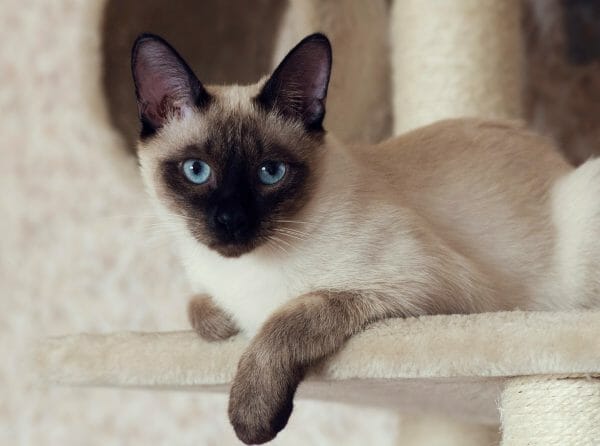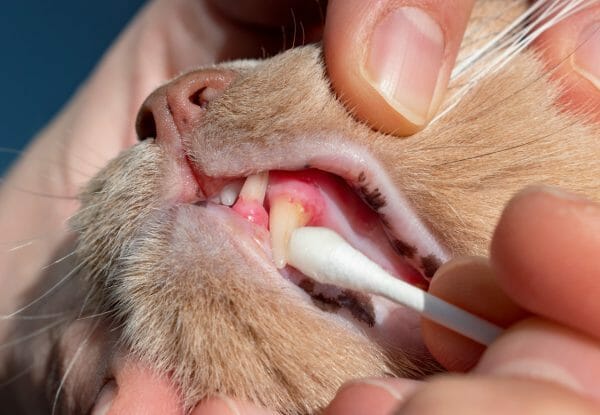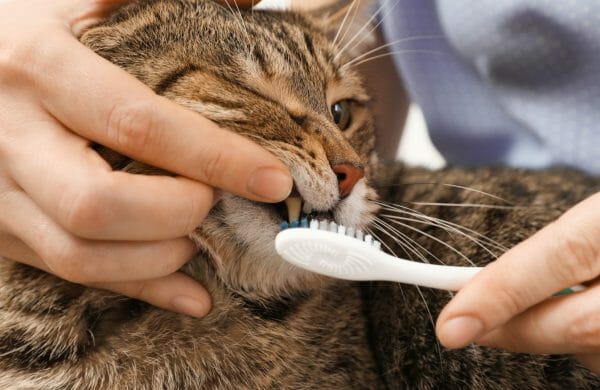Stomatitis in Cats
Feline stomatitis (also known as caudal oral stomatitis) is a painful disease that causes considerable inflammation within a cat’s mouth, including around the mucous membranes and the gingiva (gum tissue). The condition is often referred to by veterinarians as feline chronic gingivostomatitis (FCGS). This disease affects as many as 10% of cats.
Stomatitis in cats may be caused by the immune system’s reaction to the accumulation of plaque bacteria on the teeth. This reaction causes widespread inflammation in the caudal of the oropharynx (the back of the oral cavity). Cats suffering from this condition will have difficulty eating or grooming, and their quality of life will be affected.

Stomatitis in Cats Symptoms
Stomatitis in cats can present with several symptoms.
- Halitosis (bad breath)
- Excessive drooling
- Inflammation of the gums
- Decreased appetite
- Difficulty swallowing
- Weight loss
- Poor coat
- Pain inside the mouth
- Pain in the face
- Lethargy
- Pawing the face
- Reclusiveness
Cats that experience stomatitis will often have periodontal disease, a condition that affects the gum. Another condition that often appears is tooth resorption, where the body starts to break down infected teeth.

What Causes Feline Stomatitis?
The exact causes of feline stomatitis are not clearly understood. However, it is believed that there are multiple contributing factors. In some cats, viral causes have been noted, along with autoimmune and chronic immune stimulation elements. Cats with both excessive and inadequate immune responses appear to be at risk.
For some cats affected by stomatitis, the formation of plaque on the teeth can spark an allergic reaction. Inflammatory dental diseases (such as resorptive lesions and periodontal disease) may also play a part in causing the condition.
The most likely cause is that the presence of plaque in the mouth of a cat accompanied by a disproportionate immune system response. This overreaction leads to inflammation. Unless there is early intervention, this could develop into a severe autoimmune response where the cat’s body attacks its own dental tissue.
Evidence also suggests that, although not a cause, calicivirus can also play a role in a cat developing FCGS, along with the feline immunodeficiency virus (FIV) and feline leukemia virus (FeLV).
Although any cat has the potential to develop feline stomatitis, older pets are at an increased risk along with several purebred breeds such as:
- Abyssinian
- Persian
- Siamese
There is also an indication of a link between conditions such as diabetes mellitus and kidney disease with sufferers more prone to developing stomatitis.

How to Diagnose Stomatitis in Cats
Cats that exhibit any of the symptoms of stomatitis should be taken to a veterinarian for a full examination. This will typically involve a physical examination along with a complete blood count, a chemistry panel, and tests for diseases such as FIV and FeLV.
Because of the presence of the stomatitis infection, examination of the mouth can be challenging for the veterinarian as the cat will not be likely to allow its mouth to be opened. In many cases, sedation may be required to ensure that a full assessment can be made and that the cat is comfortable.
Stomatitis can usually be diagnosed through the identification of clinical signs, along with the findings of additional tests. Dental X-rays may also prove beneficial to the veterinarian as these will determine to what extent the cat is affected by periodontal disease.
In some cases, the veterinarian will also carry out a biopsy to take a sample of tissue from the cat’s mouth. This will provide a differential diagnosis to rule out the potential for oral cancer.

Feline Stomatitis Treatment
Treatment and management of this condition can be difficult due to a lack of clarity surrounding the root cause. The effectiveness of the prescribed treatment will also vary depending on how far the disease has progressed.
The first line of treatment should always be to provide a good standard of dental hygiene for the cat. Dental cleaning to remove any buildup of plaque and tartar while also cleaning below the gum line will help treat the cause of the inflammatory dental disease. Treatment such as this should be done under anesthetic.
Following this, it is important to clean the cat’s teeth regularly. Where the pain levels are still too high to sustain brushing, an oral chlorhexidine rinse or gel can be used.
The primary aim of any treatment will be to manage pain and reduce inflammation. When this does not prove to be effective, the veterinarian may suggest that the affected tooth, or even all the teeth, be extracted under anesthesia.
Although this is a drastic step, cats typically manage well without teeth as long as a soft diet is provided. By removing the teeth, all plaque retentive surfaces will be eradicated, and the risk of immune response will decrease.
In addition to these treatments, the veterinarian may also suggest:
- Prescribed pain medication (such as gabapentin)
- Antibiotics
- Laser therapy
- Interferon use
- Immunosuppressive therapy

Preventing Stomatitis in Cats
Carrying out regular tooth brushing and maintaining a good standard of oral hygiene will help minimize the chances of some milder cases of stomatitis. However, when a hyperimmune response to the presence of plaque is the cause, the disease cannot be avoided. At the onset of the disease, good oral hygiene will reduce the severity of the condition and may slow its progression.
Because feline stomatitis can present in a similar manner to oral cancer, it is important to seek out a full diagnosis at the earliest opportunity. Additionally, the longer a cat goes without treatment for stomatitis, the worse the symptoms will be.
How Long Do Cats with Stomatitis Live?
Cats with stomatitis can expect to live for many years. However, if the condition is not sufficiently managed, they will experience considerable pain and discomfort. In addition to the pain associated with stomatitis, the cat may develop secondary conditions relating to its inability to eat or groom itself.
Following a full mouth extraction, the prognosis is usually good, and the cat should improve adequately. Regardless of the treatment method used, a small percentage will not see significant improvement.



